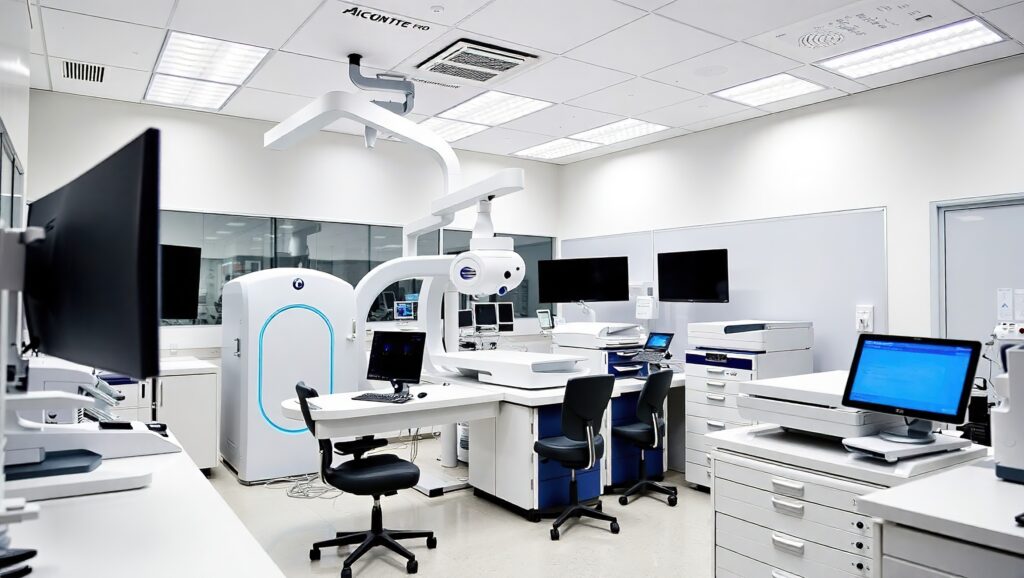Summary: Magnetic Resonance Imaging (MRI) is a widely used diagnostic tool in modern medicine. However, its strong magnetic fields can turn metal objects into dangerous projectiles and lead to serious or even fatal injuries. This article examines how metallic items compromise MRI safety, highlighting the science behind the risks, real-life incidents—including a recent case in New York—and the critical safety protocols in place to protect both patients and staff.
Keywords: MRI safety, magnetic field risks, metal objects, projectile incidents, thermal burns, MRI accident
Introduction: An Invisible but Powerful Force
Magnetic Resonance Imaging (MRI) has become a cornerstone of medical diagnostics, offering non-invasive, high-resolution images of organs and tissues. It is invaluable for diagnosing conditions affecting the brain, spine, joints, and other areas. However, the safety of MRI depends on the careful control of one key element—metal.
The powerful magnetic field at the heart of an MRI scanner can make even everyday metallic items hazardous. Jewellery, belts, hairpins, or surgical implants can not only disrupt image quality but also pose serious threats to life and limb. Recent incidents continue to highlight the dangers of these situations, particularly when protocols are not followed or breached.
The Magnet Behind the Machine: How MRI Works
MRI scanners work by producing a strong, static magnetic field—usually 1.5 or 3 tesla in strength. To put that into context, these magnets are over 60,000 times stronger than the Earth’s natural magnetic field. Alongside this, the system uses radiofrequency (RF) pulses and gradient fields to manipulate hydrogen protons in the body, creating detailed images without the use of ionising radiation.
It is the magnetic field that presents the most significant risk. Ferromagnetic materials, such as iron, nickel, and cobalt, become strongly attracted to the magnet. If such an object is brought too close to the scanner, it can be pulled in with enormous force, becoming a dangerous projectile.
The Projectile Effect: Metal Turns Deadly
Perhaps the most widely recognised danger associated with metal in an MRI suite is the projectile effect. When metal objects enter the scanner room, they can be yanked toward the magnet at high speed, causing serious injury or damage. Known colloquially as the “missile effect”, this phenomenon has caused numerous accidents worldwide.
Infamous cases include large oxygen canisters, scissors, wheelchairs, and even cleaning equipment being pulled into the magnet. These incidents highlight the sheer force of the magnetic field—and how easily a momentary lapse in attention or a communication breakdown can have severe consequences.
A Recent Case: MRI Accident in New York
One of the most recent and serious examples occurred this week in Westbury, New York. A 61-year-old man was critically injured at Nassau Open MRI, a freestanding imaging centre, when he entered an MRI suite while a scan was already in progress.
According to early reports, the man was wearing a large metallic chain around his neck. Upon entering the scanner room, the chain was forcefully pulled toward the MRI magnet, dragging the man with it. The sudden and violent motion reportedly caused a “medical episode”, though the exact nature of the injury has not yet been made public.
Emergency services were called, and the man was taken to a local hospital in critical condition, where he remains. The reason he entered the room is currently unclear, and an investigation is underway.
This incident highlights the persistent risks of complacency, poor communication, or security lapses associated with MRI scanners. Even in facilities with experienced staff, the possibility of a serious accident remains ever-present if safety measures are not rigorously maintained.
Thermal Burns: When Metal Heats Up
Not all injuries involve large objects. In fact, smaller metallic items in direct contact with the skin can become hot due to RF pulses used during scanning. Metal acts as a conductor and can absorb and amplify the radiofrequency energy, leading to burns. These injuries can range from minor discomfort to significant thermal trauma.
Examples include burns from transdermal patches with metallic backing, body piercings, and even underwire bras. Patients may not always be aware that these items are problematic, especially if the metal is embedded or concealed.
Tattoos containing metallic pigments have also been associated with localised heating. While these reactions are usually mild, there have been cases of blistering and inflammation requiring medical attention.
Diagnostic Interference: Compromising the Image
Even if a metallic object does not injure the patient, it can still distort the scan results. Metal alters the magnetic field locally, creating artefacts—distorted or obscured areas on the image. This is particularly problematic in brain, spinal, and musculoskeletal scans, where clarity is essential for accurate diagnosis.
Items like dental fillings, hearing aids, surgical staples, and zips in clothing can all lead to artefacts. These distortions may necessitate repeating the scan, which wastes time and increases costs. More seriously, they can mask signs of disease or injury, leading to missed or delayed diagnoses.
Implants and Devices: Know Before You Scan
Medical implants present a particular challenge. While many modern devices are now labelled “MRI-conditional” (meaning they are safe under certain conditions), older implants may not be compatible at all. Pacemakers, defibrillators, cochlear implants, neurostimulators, and certain types of vascular clips can be affected by the magnetic field or RF energy.
Implantable devices can malfunction, dislodge, or cause internal heating when exposed to an MRI scan. For this reason, a detailed pre-scan checklist is essential. This includes obtaining a comprehensive medical history, verifying device labels, and frequently consulting the manufacturer for safety data.
Errors in this area can be catastrophic. Cases have been reported where implanted cardiac devices failed during an MRI scan, leading to serious cardiac events.
A History of Preventable Accidents
Unfortunately, the recent case in New York is not unique. Over the past two decades, numerous MRI-related injuries and near misses have been reported.
In 2001, another high-profile case involved a six-year-old boy who died after an oxygen tank was brought into the scanner room at a New York hospital. The tank was drawn into the machine and struck the child’s head, causing fatal trauma. That tragedy led to widespread scrutiny of MRI safety protocols and remains a key example used in staff training around the world.
Other reported cases include staff members struck by metal chairs, burns from electrodes that were not adequately insulated, and patients with metal splinters in their eyes suffering severe pain and injury during scanning.
MRI Safety Protocols: Defences Against Disaster
To prevent these kinds of incidents, MRI facilities implement a range of safety protocols. These include:
Screening procedures: Patients and staff must be screened for metal objects and implants. Pre-scan questionnaires and verbal confirmation are standard.
Changing into gowns: Patients are usually required to change out of street clothes to avoid hidden metal such as zips, clips, or coins.
Restricted access: The MRI environment is divided into four zones, with Zone IV being the scanner room itself. Access is strictly controlled and limited to trained personnel.
Ferromagnetic detectors: Some facilities now use metal detectors specifically designed to identify magnetic metals, not just general conductivity.
Emergency training: All MRI staff are trained in emergency procedures, including how to quench the magnet (release the magnetic field) in a life-threatening situation. However, this is a last resort measure that can damage the machine and should only be used as a last resort.
Patient Education: Playing a Vital Role
Patients are the last line of defence against MRI accidents. They must be encouraged to speak up if they have implants, metal injuries, or concerns about any items they are wearing. This includes disclosing older tattoos, dental work, or past surgeries.
Providing patients with clear, accessible information—both in writing and verbally—is key to preventing avoidable incidents. Patients should also be informed about the importance of these questions, so they do not dismiss them as routine bureaucracy.
Technological Developments and Future Safeguards
The field of MRI safety continues to evolve. Some newer scanners have built-in systems that monitor for temperature increases on the skin, reducing the risk of burns. Smart implants and wearable tech may soon be able to transmit their compatibility status automatically to the scanner.
Artificial intelligence and machine learning are being explored to automate parts of the screening process and predict potential hazards based on patient data. Innovations in scanner design and safety alert systems aim to reduce human error.
Nevertheless, these advances must complement—not replace—proper training, vigilance, and adherence to safety protocols.
Safety is Everyone’s Responsibility
The MRI scanner is a powerful tool, but its power comes with real risks. The recent case in New York, where a man was critically injured after entering an active MRI suite wearing a metal chain, is a sobering reminder of what can go wrong. From projectile injuries to severe burns, the consequences of metal in the MRI environment can be swift and devastating.
Safety requires teamwork between radiographers, clinicians, administrators, and patients. With rigorous protocols, ongoing training, and open communication, risks can be effectively managed.
Ultimately, understanding and respecting the power of the MRI scanner is not just good practice—it is essential for protecting lives.
Disclaimer
The information provided in this article is intended for general informational purposes only and should not be construed as medical advice, professional guidance, or a substitute for consultation with qualified healthcare professionals. Open Medscience has made every effort to ensure the accuracy of the content at the time of publication, but makes no guarantees as to its completeness or ongoing accuracy. Any reference to specific incidents, including the case in New York, is based on publicly available reports and is included solely to illustrate the importance of MRI safety. Individuals should always consult with medical practitioners or MRI safety experts regarding personal health concerns, implants, or safety considerations before undergoing an MRI scan. Open Medscience accepts no responsibility for any loss, injury, or damage resulting from reliance on the information contained within this article.




